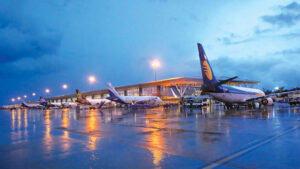There are certain areas that require attention to boost private sector participation.
Maulesh Desai, Director, CareEdge Ratings How do you view the current airport infrastructure developments in the country? Airport infrastructure development in India is largely dependent on two factors - firstly, demand outlook for air travel and secondly, regulatory framework encouraging private sector participation. According to Airports Council International (ACI), global passenger traffic growth shall be

Maulesh Desai
Director, CareEdge Ratings
How do you view the current airport infrastructure developments in the country?
Airport infrastructure development in India is largely dependent on two factors - firstly, demand outlook for air travel and secondly, regulatory framework encouraging private sector participation. According to Airports Council International (ACI), global passenger traffic growth shall be driven by Asia Pacific over the next two decades ending 2040. Within this, India is expected to be second fastest growing country by passenger numbers after Indonesia. Economic recovery in emerging markets like India has outpaced that of advanced economies. Furthermore, re-opening of China - the second major aviation market after the United States of America, and its large labour market act as an important boost to global passenger traffic.
According to ACI, global passenger traffic is forecasted to reach 92% of 2019 levels in calendar year 2023 and 104% in CY24. Although demand for leisure travel is likely to remain strong in the first half of 2023, growth levels may be subdued in the later-half of 2023 as the effects of higher interest rates are felt across economies.
In India, passenger traffic has recovered to 95% of 2019 levels in financial year 2023 itself. While the domestic traffic witnessed near full recovery of pre-pandemic level during FY23, international traffic recovered to 85% of the pre-pandemic levels. CareEdge Ratings expects the buoyancy to continue in passenger traffic and surpass pre-Covid levels by 1.12 times during FY24 to reach 385 million passengers. The momentum is expected to continue in FY25 with a double-digit year-on-year growth of 12%. India's advantageous demographics, characterised by a substantial working population (67% in the 15-64 age group in 2020), an expanding middle class, and a rising per capita income, are expected to propel the growth of air passenger traffic. This is further supported by the fact that Tier 2/3 airports experienced a higher CAGR of 16% in passenger traffic over FY16-22, compared to the compounded annual growth rate (CAGR) of 11% witnessed by tier-I airports until 2020. Besides, major Indian airline operators have started augmenting their fleet capacity, which is evident from their large orders of 1,000 aircraft to be delivered by FY27 auguring well for the passenger growth prospects. Hence, CareEdge Ratings expects significant investments in the major airports of India to handle incremental traffic of 95 million passengers by FY25 over and above peak traffic handled by Indian airport in the Pre-Covid arena.
Government of India plans to increase airports from 140 in FY23 to 225 by FY25 while adding airports at Tier 2/3 cities. There are ongoing large brownfield expansions to decongest existing capacities apart from construction of greenfield capacities at Bhogapuram, Vizag, Navi Mumbai and Noida.
On the flip side, significant disparity in tariff calculation between major airports governed by Airport Economic Regulatory Authority of India (AERA) regulations and non-major airports governed by Ministry of Civil Aviation (MoCA) has led to lacklustre response for privatization. Privatization of airports are delayed significantly as compared to 25 airports targeted between 2022-2025 under National Monetization Policy. Going forward, reforms in narrowing disparity in calculation of major and non-major airports shall pave way for privatization of airports and consequently boost airport infrastructure development.
How do you see the passenger and freight transport services at Indian airports?
India has 12 PPP and JV airports (Ahmedabad, Lucknow, Guwahati, Jaipur, Mangalore, Thiruvananthapuram, Delhi, Mumbai, Bangalore, Hyderabad, Nagpur and Cochin) which together handled almost 62% of the total passenger traffic of 327 million during FY23. Currently, Delhi and Mumbai airports have near 80% capacity utilization leading to traffic congestion. The traffic congestion is expected to reduce with ongoing capacity expansion at Delhi airport by 30 million passengers as well as new airport with the Phase-1 capacity of 12 million passengers at Noida and upcoming new airport at Navi Mumbai with Phase-1 capacity of 20 million passengers. Apart from resolving decongestion, addition of new airports is likely to result into higher passenger traffic due to new route development as evident from higher traffic volumes due to commencement of second airport in Goa.
Total cargo handling capacity at Indian airports is estimated at 42 lakh metric tonne per annum as on March 31, 2022 with capacity utilization of almost 50%. With increased focus on cargo terminals under PM Gati Shakti, the capacity utilization of major airports is expected to improve going forward.
Three main criteria for aviation services are affordable fares, on time performance and hassle-free services. Heightened Aviation Turbine Fuel (ATF) prices as well as moderation in performance of few airline players had led to volatile performance of industry in FY23. However, addition of around 1,000 new fleets as well as development of new airports is expected to result into new route development strategies and hence improve the competitiveness and on-time performance of industry players leading to better passenger satisfaction.
How is UDAN scheme fulfilling the needs of regional connectivity and what is the operational scenario? What is the scope for freight transportation at these airports?
The primary objective of UDAN scheme was to enhance regional air connectivity and make air travel affordable for the common citizens of India. As on May 31, 2023, 475 UDAN routes involving 72 airports have been operationalized. These airports are largely operated by Airports Authority of India (AAI) with considerably lower tariff as compared to major airports taking care of viability of UDAN scheme. While UDAN scheme has seen some success, hindrances in the form of moderate to weak financial viability of airlines, lack of sustained market demand and infrastructural bottlenecks have restricted it from being entirely successful. Total cargo handling capacity at airports in India is estimated at 42 lakh metric tonne per annum as of March 31, 2022 with almost 50% capacity utilization witnessed in peak cargo handling period of FY22 basis industry sources. There is a focus on cargo terminal under PM Gati Shakti. However, these capacities are largely contributed by major airports with over 75% share in total cargo handling capacities. Hence, in our view, in the near term there is limited upside potential both in scope and opportunities of freight transportation at UDAN airports.
Delay in airport projects is a major challenge today. How do you react to this and what is the way forward?
Like in any infrastructure project, availability of unencumbered land poses a major challenge for the timely completion of airport projects. Delay in the receipt of necessary approval mainly from Ministry of Environment and Forests apart from clearance/permission delays with respect to master plans are prominent hurdles in project execution. Project implementation risks have further deepened due to emerging requirements to comply with Environmental, Social and Governance (ESG) norms. Nevertheless, declaring commencement date for construction post receipt of all requisite approval can mitigate the probable risk involved to tackle execution delays. Moreover, project execution risk for airports sector is perceived lower as compared to other large sub-sectors of infrastructure like roads, urban infrastructure and greenfield ports development.
What are the key technology trends emerging in airports sector?
Various technologies already implemented at airports such as E-boarding passes and automated tray retrieval systems have helped improve operational efficiency. Self-bag drop is one of the new technologies being implemented at some of the airports in India which will significantly reduce long queue and time with streamlining of the baggage drop-off process.
Further to improve efficiency at the airports, airports can implement biometric authentication and screening system at airports which are increasingly being implemented worldwide for security and immigration purposes. Going forward, biometric technology is expected to become more widespread under the IATA One ID initiative, with passengers using biometric identification to check-in, go through security, and boarding flights. These initiatives are expected to improve customer satisfaction. Further, as per ACI study, every 1% increase in customer satisfaction lead to 1.5% increase in non-aero revenue. Hence, hassle-free travel through use of technology shall also pave way for monetization of non-aero revenue.
Apart from the improving efficiency, airports of the future need to embrace digital technology for understanding passenger needs. Airports can implement sensor networks and with the help of data integration and analytics, airports can better understand customer needs and position service offerings in order to enhance customer experiences and enhance non-aero revenues.
Airports can implement new-age technologies such as artificial intelligence (AI) to assist in efficiently manage hassle-free traffic, optimize area allocation and maximizing traffic movement to serve larger passenger capacity without incremental capex.
How do you look at the emerging opportunities for airports?
As the Indian airport sector gears up for remarkable growth, there are certain areas that require attention to boost private sector participation. One crucial aspect is the timely release of first tariff order without deferment of approved revenue requirement to next control period, which will provide revenue visibility and attract investor interest in financing. Collaboration between airports and airlines is also essential to develop viable and profitable route strategies. Adopting a collaborative approach, such as implementing hub-and-spoke methods, can facilitate airlines in optimising fleet planning and ensuring efficient passenger travel.
CARE Ratings estimates capex of around Rs 70,000 crore over FY24-FY25 mainly to decongest existing capacities and create greenfield capacities. Capex shall be dominated by PPP airports with 60% of the capex estimated at non-metro cities auguring well for the traffic prospects for tier-II cities. Total debt requirement is estimated at around Rs 50,000 crore towards capex. However, funding challenges are viewed relatively moderate supported by trueing-up mechanism in the future aero revenues and a longer concession period of 40-50 years strengthening refinancing flexibility.
 CARE Ratings estimates capex of around Rs 70,000 crore over FY24-FY25 mainly to decongest existing capacities and create greenfield capacities. Capex shall be dominated by PPP airports with 60% of the capex estimated at non-metro cities auguring well for the traffic prospects for tier-II cities. Total debt requirement is estimated at around Rs 50,000 crore towards capex. However, funding challenges are viewed relatively moderate supported by trueing-up mechanism in the future aero revenues and a longer concession period of 40-50 years strengthening refinancing flexibility.
CARE Ratings estimates capex of around Rs 70,000 crore over FY24-FY25 mainly to decongest existing capacities and create greenfield capacities. Capex shall be dominated by PPP airports with 60% of the capex estimated at non-metro cities auguring well for the traffic prospects for tier-II cities. Total debt requirement is estimated at around Rs 50,000 crore towards capex. However, funding challenges are viewed relatively moderate supported by trueing-up mechanism in the future aero revenues and a longer concession period of 40-50 years strengthening refinancing flexibility.
Hits: 0







